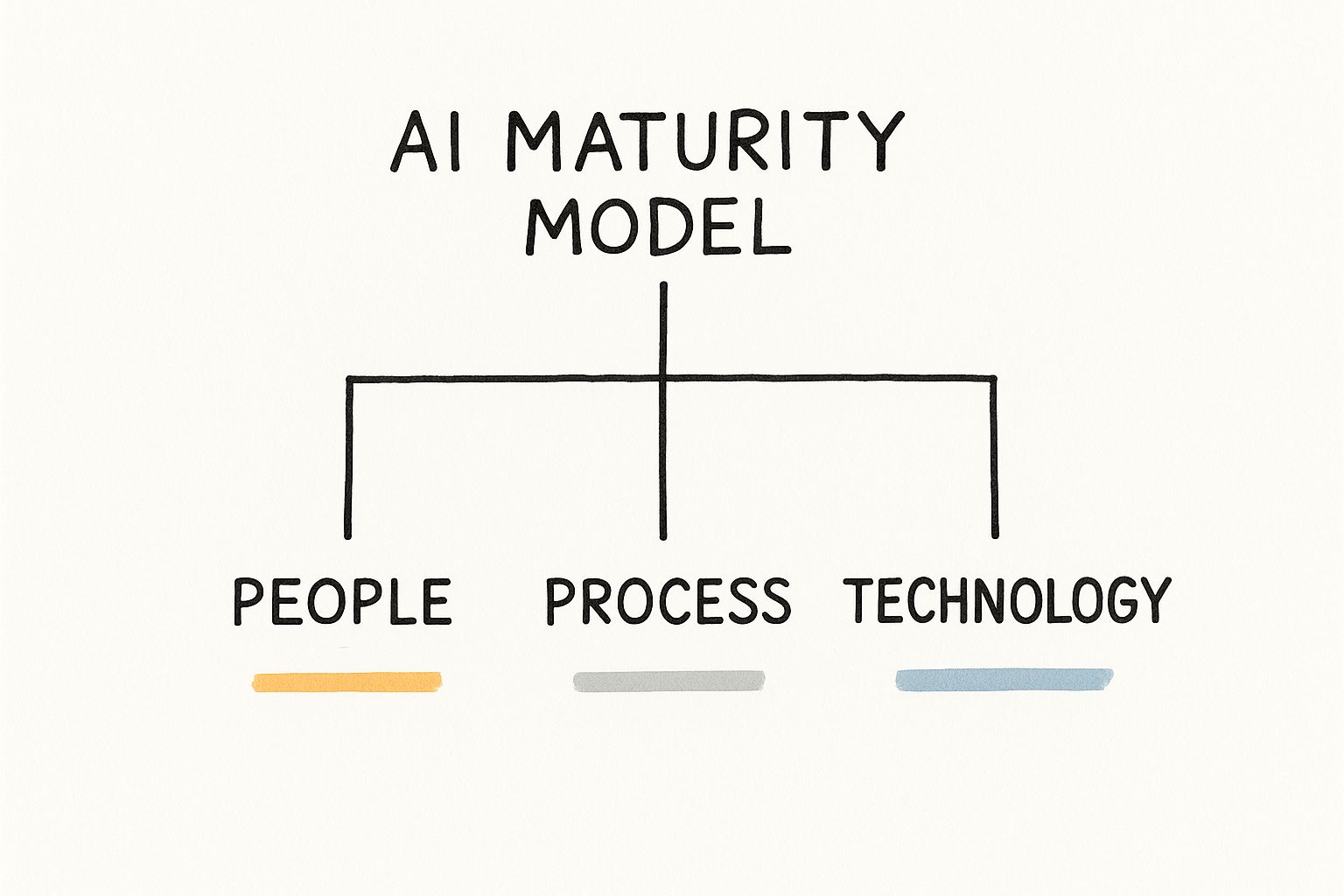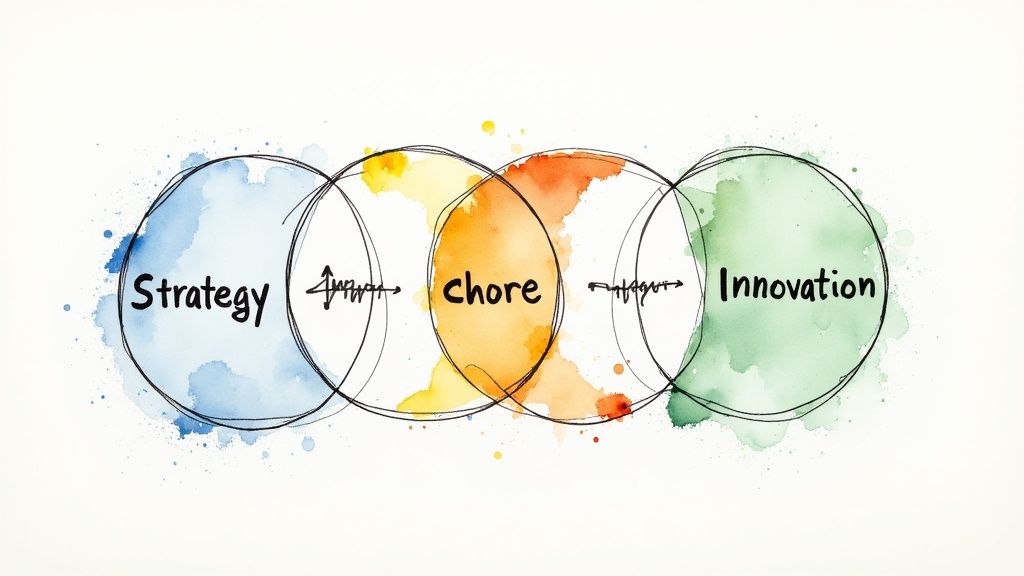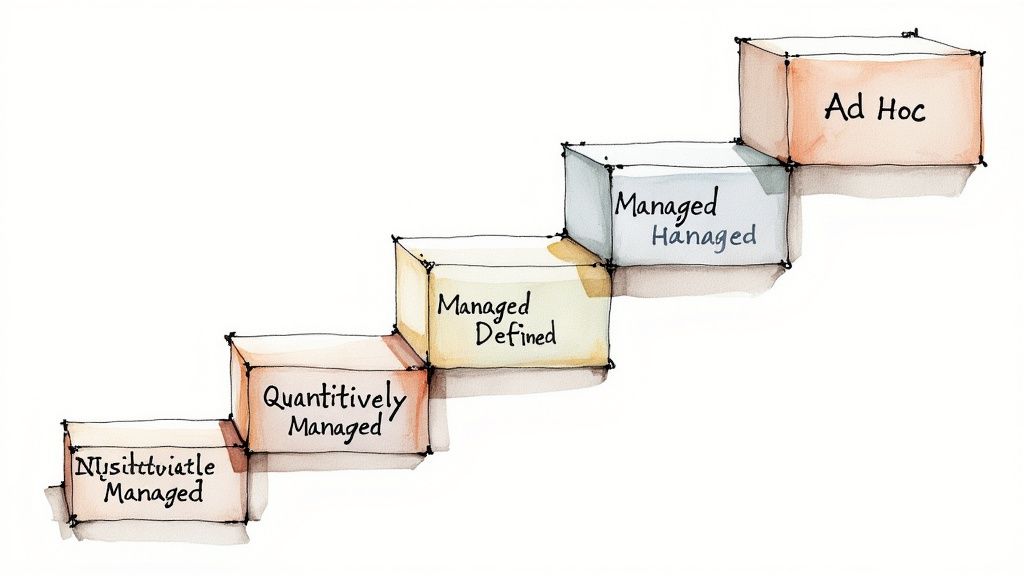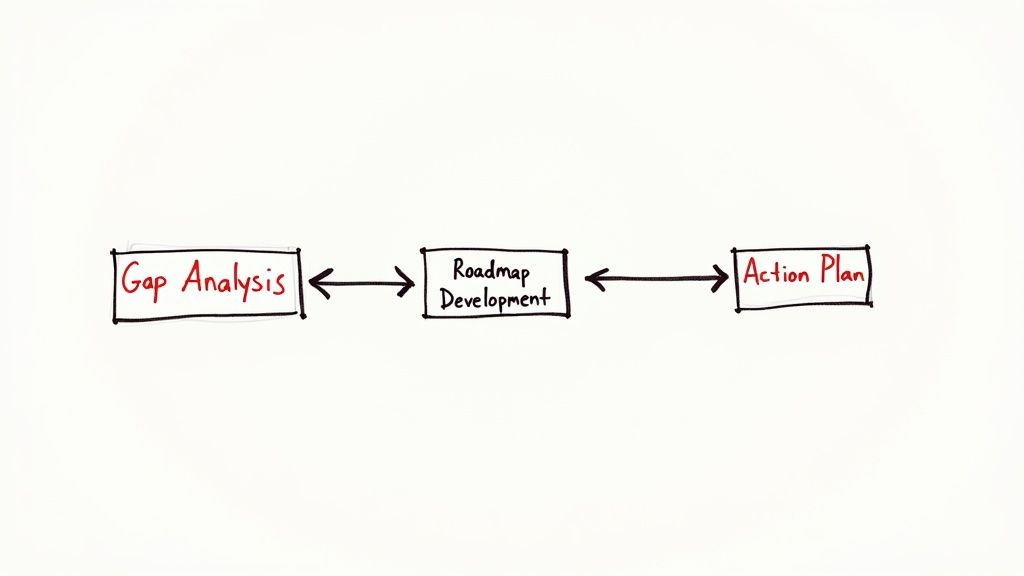A Guide to AI Maturity Models for Business Growth
Unlock business growth with AI maturity models. Our guide explains how to assess your stage and build a roadmap for successful AI transformation.

An AI maturity model is essentially a strategic roadmap that guides a business in understanding its current AI capabilities and, more importantly, plots a clear path for growth. It’s the tool that takes an organisation from running scattered, informal AI experiments to executing a cohesive, value-driven strategy.
Think of it like a GPS for your company's AI journey. It shows you exactly where you are, helps you define where you want to go, and maps out the best route to get there.
What Are AI Maturity Models and Why They Matter
So many companies are jumping into AI, but they often lack a structured plan. You see it all the time—a few pilot projects here, a team experimenting over there. These efforts frequently end up isolated, never quite delivering the significant business value everyone hoped for. This is precisely where an AI maturity model proves its worth.
It provides a clear framework for taking stock of your organisation's current state across several critical dimensions. Instead of just chasing the latest tech, a proper model forces you to evaluate your people, processes, and overall strategy. This helps you avoid the classic mistake of buying expensive, advanced tools without first building the internal skills or operational workflows to actually support them.
The journey through AI maturity is a lot like a growth chart, marking your progress through distinct stages. An organisation typically moves from simply being aware of AI's potential to embedding it as a core, strategic part of its operations. This progression isn't just about adopting new technology; it's about a fundamental shift in how the business functions, makes decisions, and ultimately creates value.
The infographic below breaks down the core pillars that every maturity model should assess.

As this visualisation shows, real AI maturity rests on a balanced foundation of people, process, and technology. Lasting success depends on advancing your capabilities across all three pillars in unison, not just focusing on one.
The Five Stages of AI Maturity
To make this concept more concrete, let's walk through the typical stages that organisations move through. Each level represents a more sophisticated and integrated use of AI. Successfully navigating these stages often involves a collaborative process of AI co creation, where business and technology teams work hand-in-hand to build solutions that solve real problems.
The primary goal is to gain a genuine competitive advantage by systematically improving how you use data and AI. Without a model, you’re essentially guessing, which is a fast track to wasted resources and missed opportunities.
A well-defined maturity assessment helps you understand precisely where you stand. The table below outlines what each level of maturity looks like in practice.
The Five Stages of AI Maturity
| Maturity Stage | Key Characteristics | Primary Goal |
|---|---|---|
| Stage 1: Awareness | Scattered, ad-hoc AI experiments. No formal strategy or dedicated resources. Awareness is limited to a few individuals. | Explore the potential of AI and build initial awareness across the organisation. |
| Stage 2: Experimental | Formal pilot projects are initiated. Small, dedicated teams start to form. Basic data infrastructure is in place. | Prove the value of AI through successful, small-scale proofs of concept (PoCs). |
| Stage 3: Operational | AI solutions are integrated into specific business processes. Standardised tools and platforms are adopted. | Scale successful pilots into production to drive efficiency in targeted business units. |
| Stage 4: Systematic | AI is integrated across multiple business functions. A central AI team or Centre of Excellence (CoE) governs strategy and standards. | Make AI a core, reliable capability that delivers consistent value across the enterprise. |
| Stage 5: Transformative | AI is fundamental to the business model and strategy. It drives new revenue streams and continuous innovation. A data-first culture is fully embedded. | Reimagine core business processes and create new market opportunities through AI. |
This structure provides a clear language for discussing progress and setting realistic goals. For instance, a business at the "Operational" stage has vastly different priorities than one just starting at "Awareness." By identifying your current stage, you can focus any AI strategy consulting efforts on the most logical next steps for meaningful growth.
The Four Pillars of a Strong AI Assessment
Getting AI right isn't just about buying the latest software. It's a balancing act across four critical areas that underpin your entire strategy. Think of it like building a house: these four pillars are your foundation. If one is weak, the whole structure could come tumbling down.
A proper, honest look at your capabilities across these domains gives you the clarity to build a plan that actually works and lasts. This complete view is at the heart of any solid AI strategy framework, making sure you're focused on what will genuinely drive growth.

Pillar 1: Technology and Infrastructure
This is the one everyone thinks of first—the engine that powers your AI work. It covers all the technical bits and pieces needed to gather, store, process, and ultimately deploy AI models. Having powerful technology is absolutely essential, but it’s only one part of the bigger picture.
Here’s what you need to evaluate:
- Data Readiness: Is your data actually usable? Clean, accessible, and well-managed data is non-negotiable. If your data is a siloed, messy nightmare, you'll never train reliable AI models.
- Tools and Platforms: Do you have the right software, cloud services, and development setups? This could be anything from off-the-shelf AI tools to a bespoke machine learning platform you’ve built yourself.
- Scalability: Can your setup handle more? A system that works for a small pilot project might buckle under the pressure of company-wide data volumes and more complex AI tasks.
Pillar 2: People and Culture
You can have the best technology in the world, but it’s just expensive decoration without the right people to use it and a company culture that’s open to change. This human element is often the hardest part to get right, but it's also the most important for success. It's a central theme, as we explored in our AI adoption guide, where we dive into how to cultivate an AI-ready workforce.
This pillar is all about:
- Skills and Expertise: Does your team have the know-how in data science, AI engineering, and general data literacy? This means spotting skills gaps and making a plan for training or hiring.
- Leadership and Sponsorship: Is there clear, visible support from the top? Getting executives on board is crucial for securing funds and driving real change.
- Organisational Mindset: Is your company culture one that encourages trying new things, making decisions based on data, and getting tech and business teams to talk to each other?
Some countries have even made this a national priority. Germany's approach to AI, for instance, is heavily focused on government-backed initiatives to boost AI skills across the entire workforce, including plans for at least 100 new AI professorships and major reskilling programmes.
Pillar 3: Process and Governance
This pillar sets up the guardrails for your AI journey. It’s what makes sure your AI projects are run efficiently, ethically, and in line with business rules. Without clear processes, AI initiatives can quickly spin out of control, becoming chaotic, risky, and totally disconnected from what the company is trying to achieve.
Governance isn't about slowing down innovation; it's about enabling it safely and responsibly. It builds trust among employees, customers, and regulators, which is essential for long-term success.
The key components here are:
- Workflows and Operations: How do you start, develop, and deploy AI projects? A standard process brings consistency and quality.
- Ethics and Risk Management: Do you have clear guidelines for responsible AI, covering fairness, transparency, and data privacy? Spotting and managing risks is paramount.
- Performance Measurement: How do you know if your AI solutions are actually working? You need clear metrics to prove their business value and ROI.
Pillar 4: Strategy and Vision
Finally, everything you do has to be tied to a clear business purpose. This pillar ensures your AI work isn't just a series of interesting technical experiments, but a direct contributor to your company’s biggest goals. A strong strategy answers the "why" behind every AI investment.
It’s the compass that guides every other decision. For example, a detailed AI requirements analysis makes sure your technical builds align perfectly with your strategic goals. Drawing from a library of real-world use cases can also help connect your vision to tangible opportunities.
A well-defined strategy should spell out:
- Business Alignment: How will AI help you hit your main business targets, like boosting revenue, improving efficiency, or creating a better customer experience?
- Competitive Advantage: How will you use AI to set your company apart from the competition?
- Investment and Prioritisation: Where will you put your money and effort to get the biggest bang for your buck?
Let any one of these four pillars weaken, and you could seriously cripple your entire AI transformation. A holistic assessment is the only way to start building a balanced and truly powerful AI capability.
Comparing the Leading AI Maturity Models
Not all AI maturity models are built the same. Think of them like different types of maps for a long journey—some are topographic, focusing on the technical terrain, while others are like road maps, showing the most direct routes for business travel. Understanding these differences is the first step to picking the right one for your company's expedition into AI.
While many popular frameworks share a similar five-stage structure, what they choose to focus on can be worlds apart. One model might be laser-focused on data readiness and infrastructure, whereas another could prioritise organisational culture, change management, and ethical guardrails. Let's break down some of the most influential models to help you find the best fit.

Choosing a model isn’t just a technical exercise; it's a deeply strategic decision. The right framework will feel intuitive to your team and sync up with your most important business goals, making the whole process of AI co creation feel more natural and effective.
The Gartner AI Maturity Model
Gartner's model is easily one of the most recognised frameworks out there. It lays out a clear, five-level path that helps businesses see where they stand and what comes next, guiding them from just kicking the tyres on AI to full-blown transformation. Its main concern is how AI is adopted and woven into the fabric of business operations.
The five stages are:
- Awareness: The organisation is still in the learning phase, exploring what AI is, but hasn't started any real projects.
- Active: The first few experiments or pilot projects are getting off the ground, often driven by a few enthusiasts without a formal mandate.
- Operational: AI becomes a formal part of some business functions. There’s a dedicated team, and AI solutions are part of day-to-day work.
- Systemic: AI is now widespread. It’s starting to disrupt old business models and unlock new levels of efficiency across the company.
- Transformational: The entire business model now hinges on AI. It’s used everywhere to create new value and stay ahead of the curve.
Gartner’s framework is a solid choice for larger companies that need a structured, high-level way to manage AI adoption across many different departments. It does a great job of framing AI as a core business strategy, not just another IT project.
The Collaborative Intelligence Capability Maturity Model (CI-CMM)
Another incredibly useful framework is the Collaborative Intelligence Capability Maturity Model (CI-CMM). This one has a unique flavour: it’s all about the partnership between people and AI. It sees true success not just in the tech itself, but in the synergy created when humans and machines work together effectively.
The core idea behind the CI-CMM is that your organisational readiness has to grow at the same pace as your technology. It helps you avoid the classic mistake of buying a powerful AI tool that nobody in the organisation is ready or able to use properly.
This model also uses five stages, but its milestones are defined by the human-machine relationship:
- Stage 1: Initial: Humans are in the driver's seat, with AI acting as a simple assistant that needs a lot of oversight.
- Stage 2: Emerging Collaboration: AI starts to augment human decisions by providing helpful insights and data.
- Stage 3: Balanced Collaboration: Humans and AI become true partners, working together to complete entire processes from start to finish.
- Stage 4: Advanced Collaboration: AI takes the lead on processes, but with a "human-in-the-loop" for supervision and critical judgment calls.
- Stage 5: Autonomous Enterprise: AI platforms can manage and govern entire processes on their own, with minimal human touch.
The CI-CMM is perfect for organisations that want to enhance their workforce's capabilities and build institutional trust in AI over time. It’s less about the tech for its own sake and more about building a formidable human-machine team.
Making the Right Choice for Your Organisation
So, which model is right for you? It really boils down to your primary goals. If you're in a large corporation and need to communicate a clear strategic vision to the C-suite, Gartner's model is an excellent tool. On the other hand, if your priority is building a culture of collaboration and ensuring your people and AI systems evolve together, the CI-CMM is probably a better fit.
To help you put these ideas into practice, our AI Strategy consulting tool can guide you through a self-assessment that considers your unique business environment. It helps turn the theoretical stages of these models into a concrete, step-by-step action plan.
The table below gives you a quick, at-a-glance comparison to help you start thinking about what might work best for you.
Comparison of Popular AI Maturity Frameworks
| Framework | Number of Stages | Primary Focus Area | Ideal For |
|---|---|---|---|
| Gartner AI Maturity Model | 5 | Strategic adoption and business integration of AI technology. | Large enterprises needing a high-level roadmap for communicating strategy and measuring progress across business units. |
| CI-CMM | 5 | The evolving symbiotic relationship between humans and AI systems. | Organisations focused on workforce augmentation, operational efficiency, and building trust in automated decision-making. |
| Ekipa Custom Framework | Tailored | Holistic alignment of Technology, People, Process, and Strategy. | Businesses of all sizes seeking a balanced and actionable path to AI maturity, from start-ups to global corporations. |
At the end of the day, the best AI maturity models aren't rigid rulebooks. They are flexible guides. They give your entire organisation a shared language and a common destination, allowing you to map a course that delivers real, tangible value.
How to Conduct Your Own AI Maturity Assessment
Knowing about AI maturity models is one thing, but actually figuring out where your company stands is a completely different ball game. A proper assessment isn't just a quick survey you send around. It's a deep-dive investigation into what your organisation is truly capable of.
Think of this as a practical playbook. We’re moving from theory to tangible insights, giving you a step-by-step guide to running your own internal AI maturity assessment. It’s all about getting honest feedback and seeing how your reality stacks up against a proven framework. Frankly, it's the only way to find the real gaps between where you are today and where you need to be.
Step 1: Assemble a Cross-Functional Assessment Team
Let's get one thing straight: an AI maturity assessment can't be an IT-only project. If you want a complete and accurate picture, you have to bring people in from every corner of the business. A one-sided view will give you a skewed—and ultimately useless—result.
Your dream team should have voices from:
- Leadership: You need them to ensure the assessment aligns with high-level business goals and to champion the initiatives that come out of it.
- IT and Data Teams: These are your technical experts. They’ll give you a no-nonsense view of your infrastructure, data quality, and the tools you already have.
- Business Units: People from sales, marketing, operations, and other departments ground the assessment in the real world. They know the day-to-day challenges and can spot genuine opportunities.
- HR and Finance: They bring crucial perspectives on skills gaps, training needs, and the financial reality of any future AI investments.
Putting this diverse group together is your best defence against confirmation bias and ensures the findings are actually relevant to the entire organisation.
Step 2: Gather Honest and Comprehensive Feedback
With your team in place, it’s time to start gathering information. The goal here is to collect both hard numbers and personal stories to truly understand your strengths and weaknesses across all pillars of maturity—Technology, People, Process, and Strategy. This means going way beyond a simple questionnaire.
Here are a few effective methods:
- Surveys: Use well-structured surveys to get a baseline. This helps you gauge general perceptions about AI, current skill levels, and common challenges across the company.
- Interviews: Sit down one-on-one with key stakeholders. This is where you dig into the "why" behind the survey answers and uncover the nuanced problems that don’t show up on a form.
- System Audits: Do a hands-on technical review. Look at your actual data sources, platforms, and existing AI tools to see what they can really do, not just what people think they can do.
A crucial part of this stage is a thorough AI requirements analysis. This ensures your assessment is tied to real business needs and what's technically possible. It stops you from evaluating capabilities in a vacuum and connects your findings directly to potential business value.
Step 3: Map Findings Against Your Chosen Model
Once you've collected all that information, it's time to map it against the stages of your chosen AI maturity model. This is the moment where all your raw findings transform into a clear snapshot of where you are right now. For each dimension of the model (like Gartner's stages or the CI-CMM levels), you’ll plot where your organisation sits based on the evidence you’ve gathered.
This mapping exercise is so important because it creates a shared language and a visual way to talk about maturity. It’s the point where you can confidently say, "We are at Stage 2 in data readiness but only Stage 1 in governance." It makes abstract concepts feel concrete.
Looking at international benchmarks can also add valuable context. For example, an OECD review of Germany’s AI progress highlighted a gap many organisations face: a strong research foundation but major hurdles in actually scaling AI applications, especially for SMEs. This just goes to show why a structured assessment is so vital for bridging that gap between knowing about AI and truly mastering its deployment. You can learn more from the OECD's detailed report.
Step 4: Analyse Gaps and Identify Opportunities
The final step is all about analysis. You're looking at your results to pinpoint the biggest opportunities for growth. Compare your current state to where you want to be and identify the most significant gaps. These gaps aren’t failures; they're your roadmap for action.
Prioritise these gaps based on two simple factors: business impact and feasibility. An opportunity that promises a high impact and is relatively easy to implement should jump to the top of your list.
For organisations ready to kickstart this strategic planning, an interactive session can be incredibly powerful. To see how you can benefit from turning these findings into a concrete roadmap, consider an AI strategy workshop. This structured approach ensures you focus your time, money, and energy where they’ll deliver the most value, setting you up for a powerful and successful AI journey.
Building an Actionable AI Transformation Roadmap
An AI maturity assessment is a fantastic start, but it's only valuable if it leads to action. Let’s be honest, its real purpose is to give you a clear, honest starting point for a strategic and, most importantly, achievable transformation roadmap. This is where we turn those assessment findings into a concrete plan for moving your organisation forward.

The trick is to translate your assessment data into a compelling story—one that creates a sense of both urgency and excitement for the AI journey ahead. When you have a clear plan, it's so much easier to rally teams, get that crucial executive support, and start making targeted improvements that deliver genuine business value.
Prioritising Initiatives Based on Impact and Feasibility
After your assessment, you’ll likely have a long list of potential AI projects. It could be anything from fixing data quality issues to exploring new generative AI tools. Trying to do it all at once is a classic recipe for failure. The key is to prioritise, and to do it ruthlessly.
A simple but incredibly powerful way to do this is with a 2x2 matrix. You plot each initiative based on two key factors:
- Business Impact: How much value will this project actually deliver? Will it slash costs, give revenue a real boost, or dramatically improve the customer experience?
- Feasibility: How easy is this to pull off? Think about the technical difficulty, the resources you'll need (budget, people), and how long it will take to complete.
Anything that lands in the high-impact, high-feasibility quadrant is your quick win. These should be at the very top of your list. They build momentum and show everyone the value of your AI strategy right out of the gate. On the other hand, a project with massive potential but low feasibility is a long-term strategic bet that needs very careful planning.
This prioritisation exercise is a cornerstone of our expert AI strategy consulting, where we guide businesses in shaping a roadmap that balances immediate gains with long-term ambition.
Setting Realistic Short-Term and Long-Term Goals
With your priorities straight, the next step is to define clear, measurable, and realistic goals. This is where your AI maturity model becomes your trusted guide. Think of your roadmap as a phased journey, not a frantic sprint to the finish line.
For instance, a company just starting its AI journey might set short-term goals like these:
- Next 3 Months: Establish a data governance council and complete one pilot project to automate a specific back-office task.
- Next 6 Months: Launch a company-wide data literacy programme and decide on a standard set of AI tools.
In contrast, a more mature organisation might be focused on scaling AI across different business units. Their long-term goals could involve weaving AI into core product development or using predictive analytics to drive corporate strategy.
A great roadmap tells a story of progression. It shows how small, foundational steps taken today build towards a larger, transformative vision for tomorrow. This narrative is essential for keeping everyone aligned and motivated.
The competitive landscape is making this kind of strategic planning more urgent than ever. A recent Accenture survey found that only 11% of European firms, including those in Germany, were considered 'AI Achievers' with advanced capabilities. However, forecasts predict this share will nearly triple to 29% in the coming year—a rapid acceleration that really highlights the need for a clear plan.
Securing Executive Buy-In and Building Momentum
A roadmap is just a document until it has the full backing of your organisation's leadership. Getting that executive buy-in is probably the single most critical step in turning your plan into reality. You have to present your findings and your proposed roadmap not as a technical project, but as a solid business case.
Here’s how you can build a convincing narrative for them:
- Start with the "Why": Clearly connect your proposed AI initiatives to the company's core business objectives.
- Use Data to Tell a Story: Present the results of your maturity assessment to show both the risks of doing nothing and the huge opportunities for growth.
- Show the ROI: For your top-priority initiatives, provide realistic estimates of the expected return on investment.
- Highlight the Quick Wins: Emphasise those high-impact, low-effort projects to prove that value can be delivered quickly. This builds confidence and gets the ball rolling.
By framing your roadmap around business outcomes, you create a powerful argument for investment. This isn't just about getting a signature on a budget; it's about building a coalition of champions who will help you drive the change from the top down.
Common Questions About AI Maturity Models
As organisations start to get serious about bringing AI into the fold, a lot of practical questions pop up. It’s one thing to talk about the theory of an AI maturity model, but quite another to apply it in the real world. The whole process can feel a bit overwhelming.
This section tackles the most common queries we hear from business leaders. We'll give you clear, straightforward answers to help you navigate your journey with more confidence and a solid strategic footing.
How Often Should We Assess Our AI Maturity?
Think of your AI maturity assessment like a regular health check-up for your AI strategy, not a one-and-done task. A really thorough, deep-dive assessment is best done annually. This gives you a solid benchmark to see how far you've come and to make sure your efforts are still lined up with your business goals.
But let's be realistic—the world of AI moves at lightning speed. That's why we also recommend quarterly check-ins on your key roadmap projects. These quicker reviews help you stay agile and react to new technologies, market shifts, or what your competitors are doing.
It's also critical to do a fresh, full assessment whenever your company goes through a major change. This could be a merger, a big pivot in business strategy, or even a change in leadership. In those moments, you need to re-evaluate where you stand to ensure your AI efforts align with your new reality. The model should be a living guide, not a report card you file away and forget.
Can a Small Business Use an AI Maturity Model?
Absolutely. There's a common myth that these models are just for massive corporations with bottomless budgets. The truth is, they are incredibly useful for small and medium-sized enterprises (SMEs) too. The core idea of smart, measured growth applies to everyone, no matter the size of the company.
For an SME, the model acts as a focusing lens. It helps you pour your limited resources—be it time, money, or talent—into the areas that will give you the biggest bang for your buck. A small business probably isn't aiming to build a massive in-house data science team like a large enterprise might. Instead, its roadmap could prioritise getting mature in other areas first.
For example, a small business could use the model to zero in on:
- Data Quality: Making sure all customer and operational data is clean, organised, and easy to access.
- Tool Adoption: Getting really good at using off-the-shelf AI tools for marketing or customer service instead of building custom software.
- Process Optimisation: Pinpointing one or two core business processes where AI can deliver immediate efficiency wins.
It’s not about trying to match the scale of a corporate giant. It’s about being smart, targeted, and strategic. The right model helps you do exactly that.
What Is the Biggest Mistake to Avoid?
The single biggest mistake we see is treating the AI maturity assessment as a simple tech audit. So many organisations fall into this trap. They pour all their energy into checking their tools, platforms, and data infrastructure, and they might even score high marks on the technology front. But then they wonder why they aren't seeing any real business results.
The reason? They’ve ignored the other critical pieces of the puzzle that make the tech work: people, processes, and strategy. You can have the most advanced AI tools on the planet, but they’re useless if your team doesn't have the skills to use them, if your company culture pushes back against data-driven decisions, or if your AI projects aren't tied to clear business goals. True maturity is holistic.
A close second is trying to jump to the highest level of maturity in every area all at once. This "boil the ocean" approach is a recipe for burnout and abandoned projects.
The most successful companies take a phased approach. They start by strengthening the foundations and focusing on projects that deliver quick, visible wins. This builds momentum and gets the whole organisation excited about the longer journey ahead. This is exactly where guidance from our expert team can be invaluable, helping you map out a path that’s both ambitious and realistic. For more in-depth answers, you can also explore our comprehensive FAQ page.
Ready to move from theory to action? Ekipa's next-gen AI strategy consulting platform can help you build and execute a tailored AI transformation roadmap without the costly consultant price tag.



